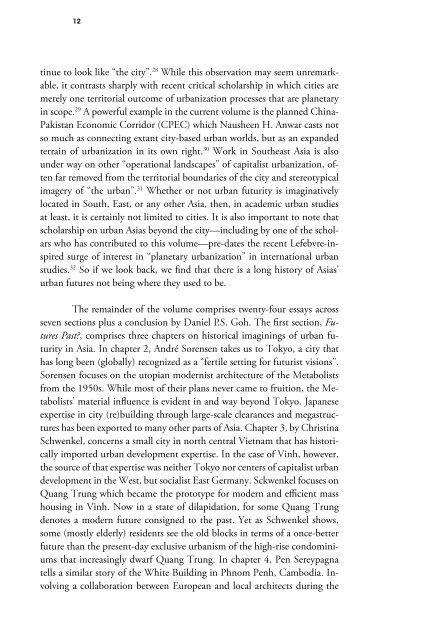Urban Asias – Essays on Futurity Past and Present
You also want an ePaper? Increase the reach of your titles
YUMPU automatically turns print PDFs into web optimized ePapers that Google loves.
12 <br />
tinue to look like “the city”. 28 While this observati<strong>on</strong> may seem unremarkable,<br />
it c<strong>on</strong>trasts sharply with recent critical scholarship in which cities are<br />
merely <strong>on</strong>e territorial outcome of urbanizati<strong>on</strong> processes that are planetary<br />
in scope. 29 A powerful example in the current volume is the planned China-<br />
Pakistan Ec<strong>on</strong>omic Corridor (CPEC) which Nausheen H. Anwar casts not<br />
so much as c<strong>on</strong>necting extant city-based urban worlds, but as an exp<strong>and</strong>ed<br />
terrain of urbanizati<strong>on</strong> in its own right. 30 Work in Southeast Asia is also<br />
under way <strong>on</strong> other “operati<strong>on</strong>al l<strong>and</strong>scapes” of capitalist urbanizati<strong>on</strong>, often<br />
far removed from the territorial boundaries of the city <strong>and</strong> stereotypical<br />
imagery of “the urban”. 31 Whether or not urban futurity is imaginatively<br />
located in South, East, or any other Asia, then, in academic urban studies<br />
at least, it is certainly not limited to cities. It is also important to note that<br />
scholarship <strong>on</strong> urban <str<strong>on</strong>g>Asias</str<strong>on</strong>g> bey<strong>on</strong>d the city—including by <strong>on</strong>e of the scholars<br />
who has c<strong>on</strong>tributed to this volume—pre-dates the recent Lefebvre-inspired<br />
surge of interest in “planetary urbanizati<strong>on</strong>” in internati<strong>on</strong>al urban<br />
studies. 32 So if we look back, we find that there is a l<strong>on</strong>g history of <str<strong>on</strong>g>Asias</str<strong>on</strong>g>’<br />
urban futures not being where they used to be.<br />
The remainder of the volume comprises twenty-four essays across<br />
seven secti<strong>on</strong>s plus a c<strong>on</strong>clusi<strong>on</strong> by Daniel P.S. Goh. The first secti<strong>on</strong>, Futures<br />
<strong>Past</strong>?, comprises three chapters <strong>on</strong> historical imaginings of urban futurity<br />
in Asia. In chapter 2, André Sorensen takes us to Tokyo, a city that<br />
has l<strong>on</strong>g been (globally) recognized as a “fertile setting for futurist visi<strong>on</strong>s”.<br />
Sorensen focuses <strong>on</strong> the utopian modernist architecture of the Metabolists<br />
from the 1950s. While most of their plans never came to fruiti<strong>on</strong>, the Metabolists’<br />
material influence is evident in <strong>and</strong> way bey<strong>on</strong>d Tokyo. Japanese<br />
expertise in city (re)building through large-scale clearances <strong>and</strong> megastructures<br />
has been exported to many other parts of Asia. Chapter 3, by Christina<br />
Schwenkel, c<strong>on</strong>cerns a small city in north central Vietnam that has historically<br />
imported urban development expertise. In the case of Vinh, however,<br />
the source of that expertise was neither Tokyo nor centers of capitalist urban<br />
development in the West, but socialist East Germany. Sckwenkel focuses <strong>on</strong><br />
Quang Trung which became the prototype for modern <strong>and</strong> efficient mass<br />
housing in Vinh. Now in a state of dilapidati<strong>on</strong>, for some Quang Trung<br />
denotes a modern future c<strong>on</strong>signed to the past. Yet as Schwenkel shows,<br />
some (mostly elderly) residents see the old blocks in terms of a <strong>on</strong>ce-better<br />
future than the present-day exclusive urbanism of the high-rise c<strong>on</strong>dominiums<br />
that increasingly dwarf Quang Trung. In chapter 4, Pen Sereypagna<br />
tells a similar story of the White Building in Phnom Penh, Cambodia. Involving<br />
a collaborati<strong>on</strong> between European <strong>and</strong> local architects during the


















